Recent Posts
The Role of Insurance in Fire Damage Restoration
4/17/2024 (Permalink)
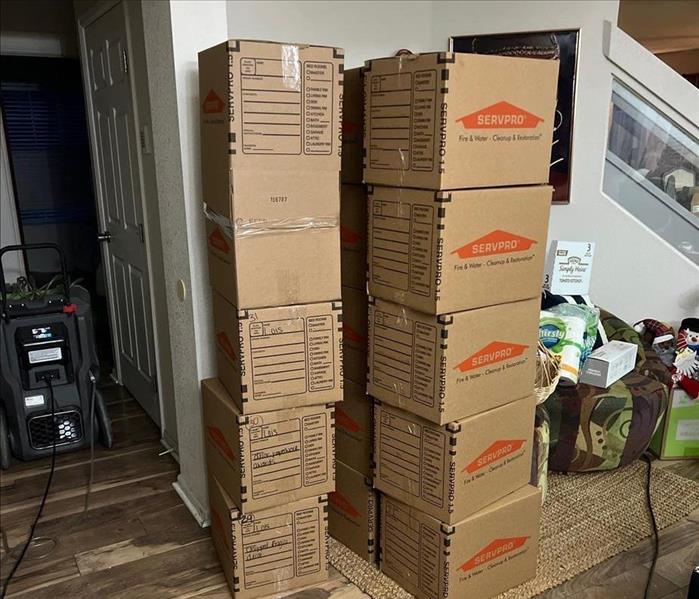 In this blog, we will explore the role of insurance in fire damage restoration, how it is involved, and how coverage affects your remediation process.
In this blog, we will explore the role of insurance in fire damage restoration, how it is involved, and how coverage affects your remediation process.
Experiencing a fire in your home or business is a devastating event that can cause significant damage and disrupt your life. Fortunately, insurance coverage can play a crucial role in fire damage restoration, helping to ease the financial burden and facilitate the remediation process. In this blog, we will explore the role of insurance in fire damage restoration, how it is involved, and how coverage affects your remediation process.
Fire Damage Insurance and Coverage
Fire damage insurance is designed to protect policyholders against the costs associated with fire-related losses. It provides coverage for repairing or rebuilding your property, replacing damaged belongings, and reimbursing additional living expenses if you need to relocate temporarily. Understanding your insurance policy and its coverage limits is key to navigating the fire damage restoration process effectively.
Contacting Your Insurance Company
After a fire, contacting your insurance company should be one of your first steps. They will guide you through the claims process, assign an adjuster to assess the damage and determine the coverage you have. It is important to provide accurate and detailed documentation of the damage, including photographs and an itemized list of the affected items.
Fire Remediation and Insurance
Proper fire damage restoration involves various stages, including assessing the damage, containing the affected area, removing debris, cleaning and sanitizing, and rebuilding if necessary. Insurance coverage can significantly impact the remediation process.
- Assessing the Damage: Insurance adjusters work closely with fire damage restoration professionals to evaluate the extent of the damage. Their assessment helps determine the scope of the restoration project and the coverage that applies.
- Containment and Mitigation: Insurance coverage often includes provisions for emergency services, such as water extraction to prevent further damage and the installation of temporary board-ups and tarps to secure the property. These measures are essential in minimizing losses and protecting unaffected areas.
- Cleaning and Restoration: Insurance coverage typically funds professional cleaning and restoration services. Trained technicians employ advanced techniques to remove soot, smoke residues, and odor from surfaces, ensuring comprehensive restoration.
- Structural Repairs and Reconstruction: If your property requires structural repairs or reconstruction, insurance coverage helps cover the associated costs. This includes repairs to walls, floors, ceilings, and other affected areas.
- Content Restoration and Replacement: Insurance policies generally cover the costs of cleaning and restoring your personal belongings damaged by the fire. In cases where items cannot be fully restored, insurance may provide reimbursement for replacements.
Fire damage is distressing and overwhelming, but insurance coverage can help alleviate some of the financial burdens associated with restoration. From assessing the damage to cleaning, rebuilding, and replacing belongings, insurance plays a vital role throughout the entire fire damage restoration process. By understanding your policy and promptly contacting your insurance company, you can ensure a smooth and efficient remediation process.
Remember, each insurance policy is unique and may have specific coverage details. Reviewing and understanding your policy thoroughly, including any exclusions or limitations is essential. Partnering with a professional fire damage restoration company like SERVPRO® can also help navigate the complexities of the process, ensuring your restoration is done efficiently and to the highest standard.
Mold Removal vs. Mold Remediation: What's the Difference?
3/13/2024 (Permalink)
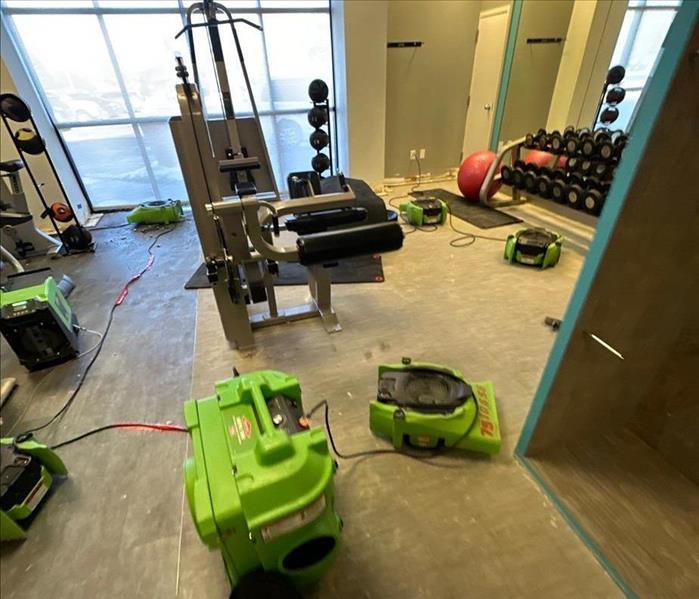 When faced with mold damage in your home, it's essential to understand the difference between mold removal and mold remediation.
When faced with mold damage in your home, it's essential to understand the difference between mold removal and mold remediation.
When faced with mold damage in your home, it's essential to understand the difference between mold removal and mold remediation. While the terms are often used interchangeably, they signify two distinct approaches to addressing mold issues. In this article, we will explore the major differences between mold removal and mold remediation to help you make an informed decision when dealing with mold damage.
Mold Removal 101
Mold removal refers to the act of physically removing mold from surfaces in your home. This approach involves scrubbing or wiping away visible mold growth using cleaning agents or biocides. While mold removal may eliminate the visible mold, it does not address the underlying cause or prevent future mold growth. Here are a few key points to consider:
- Surface-Level Approach: Mold removal primarily focuses on the visible mold on surfaces such as walls, ceilings, or floors. The goal is to eliminate the mold to create a clean and aesthetically pleasing appearance.
- Limited Scope: Mold removal typically does not involve addressing the source of moisture that caused the mold growth. As a result, if the underlying moisture problem is not resolved, the mold may reappear over time.
- Risk of Mold Spores: During the removal process, the disturbed mold spores can become airborne and spread to other areas of your home, potentially leading to further contamination.
- Appropriate for Small-Scale Contamination: Mold removal is generally suitable for small, isolated areas of mold growth, such as a small patch on a bathroom wall.
Mold Remediation 101
Mold remediation takes a comprehensive and systematic approach to address mold damage in your home. It involves not only removing the visible mold but also addressing the underlying cause, preventing further spread, and restoring the affected area to its pre-damage condition. Here's what you need to know about mold remediation:
- Identification and Source Elimination: Mold remediation starts with a thorough inspection to identify the extent of mold damage and the source of moisture. Remediation professionals focus on fixing the underlying issue to prevent future mold growth.
- Containment and Prevention: To prevent the spread of mold spores, professionals establish containment measures using barriers and negative air pressure. This ensures that mold spores are contained within the work area during the remediation process.
- Mold Removal and Cleaning: Mold remediation includes safely removing and disposing of mold-contaminated materials. Specialized cleaning agents and techniques are used to thoroughly clean and sanitize the affected surfaces.
- Drying and Restoration: After removing the mold, the affected area is dried using professional-grade equipment. Restoration may involve repairing or replacing damaged materials to bring the area back to its original condition.
- Preventative Measures: To prevent future mold growth, remediation professionals may recommend implementing moisture control measures, improving ventilation, and maintaining proper humidity levels.
Mold Remediation vs. Mold Removal
While mold removal focuses on eliminating visible mold growth, mold remediation takes a more comprehensive approach by addressing the root cause, preventing further spread, and restoring your home. For significant mold damage or recurring mold issues, it's best to enlist the help of professionals like SERVPRO® who specialize in mold remediation. If you want a thorough, long-term solution to mold damage in your home, trust the experts to provide you with effective mold remediation services. Contact us today to schedule your mold remediation appointment and restore a safe and healthy living environment in your home.
How SERVPRO Improves the Air Quality in a Home After Water Damage
2/14/2024 (Permalink)
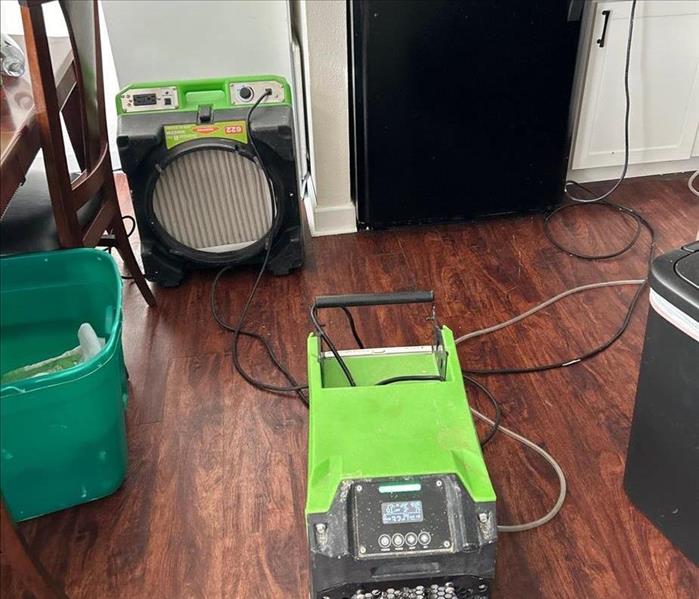 Water damage not only affects the structural integrity of your home but can also compromise indoor air quality.
Water damage not only affects the structural integrity of your home but can also compromise indoor air quality.
Water damage not only affects the structural integrity of your home but can also compromise indoor air quality. When faced with water damage, addressing the visible signs might not be enough. At SERVPRO of North Thornton/Brighton, we understand the importance of restoring not just the structure but also ensuring optimal indoor air quality post-water damage. In this blog, discover how our comprehensive approach helps improve the air quality in your home after water damage.
Understanding the Impact of Water Damage on Indoor Air Quality
Water intrusion creates an environment conducive to mold and mildew growth, which can significantly impact indoor air quality. Mold spores, along with dampness and moisture, can easily spread through the air. Additionally, stagnant water can lead to the growth of bacteria, further compromising the air you breathe.
SERVPRO's Proven Techniques for Air Quality Improvement
- Thorough Assessment: Our process begins with a meticulous inspection to identify areas affected by water damage and potential microbial growth. We employ advanced tools like moisture meters and thermal imaging cameras to detect hidden moisture pockets.
- Professional Drying and Dehumidification: Utilizing industrial-grade equipment, including high-powered air movers and dehumidifiers, we thoroughly dry affected areas, reducing moisture levels and inhibiting mold and bacterial growth.
- Meticulous Cleaning and Sanitization: Our expert technicians employ industry-approved disinfectants and specialized techniques to clean and sanitize affected surfaces, eliminating contaminants and improving air quality.
- HEPA Filtration and Air Purification: We utilize HEPA filtration systems and air scrubbers to capture airborne particles, mold spores, and other contaminants, ensuring cleaner, fresher indoor air.
Benefits of Our Approach
Our approach ensures not only structural restoration but also the improvement of indoor air quality, promoting a healthier living environment for you and your family. With years of experience and specialized training, our technicians are equipped to handle diverse water damage scenarios and maintain high standards of air quality restoration. By addressing moisture and microbial growth promptly, we prevent further damage, ensuring long-term air quality improvement and reducing the risk of recurrent issues.
Trust SERVPRO® for Your Air Quality Restoration Needs
At SERVPRO®, we prioritize your well-being and the safety of your indoor environment. Our commitment to restoring your home after water damage extends beyond surface-level fixes to include comprehensive air quality improvement.
Don't compromise on the air you breathe. Contact our SERVPRO of North Thornton/Brighton team for professional assessment and restoration services, ensuring a better, safer home for you and your loved ones!
Mold Removal vs. Mold Remediation: What's the Difference?
1/30/2024 (Permalink)
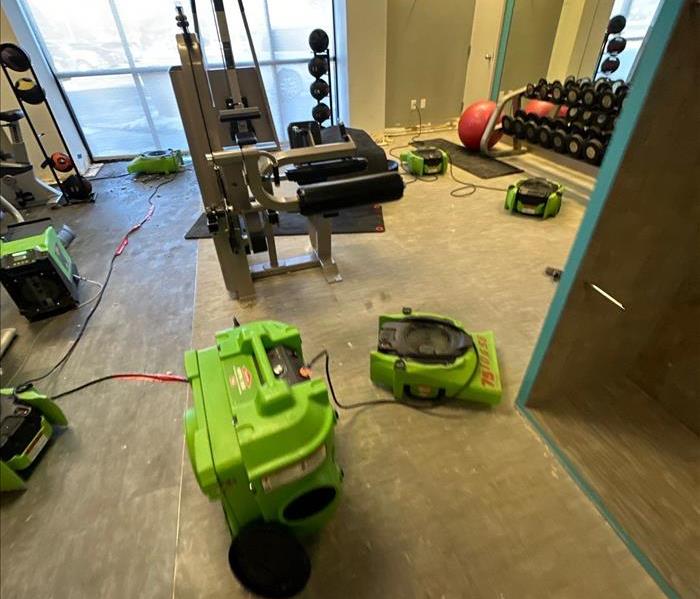 When faced with mold damage in your home, it's essential to understand the difference between mold removal and mold remediation.
When faced with mold damage in your home, it's essential to understand the difference between mold removal and mold remediation.
When faced with mold damage in your home, it's essential to understand the difference between mold removal and mold remediation. While the terms are often used interchangeably, they signify two distinct approaches to addressing mold issues. In this article, we will explore the major differences between mold removal and mold remediation to help you make an informed decision when dealing with mold damage.
Mold Removal 101
Mold removal refers to the act of physically removing mold from surfaces in your home. This approach involves scrubbing or wiping away visible mold growth using cleaning agents or biocides. While mold removal may eliminate the visible mold, it does not address the underlying cause or prevent future mold growth. Here are a few key points to consider:
- Surface-Level Approach: Mold removal primarily focuses on the visible mold on surfaces such as walls, ceilings, or floors. The goal is to eliminate the mold to create a clean and aesthetically pleasing appearance.
- Limited Scope: Mold removal typically does not involve addressing the source of moisture that caused the mold growth. As a result, if the underlying moisture problem is not resolved, the mold may reappear over time.
- Risk of Mold Spores: During the removal process, the disturbed mold spores can become airborne and spread to other areas of your home, potentially leading to further contamination.
- Appropriate for Small-Scale Contamination: Mold removal is generally suitable for small, isolated areas of mold growth, such as a small patch on a bathroom wall.
Mold Remediation 101
Mold remediation takes a comprehensive and systematic approach to address mold damage in your home. It involves not only removing the visible mold but also addressing the underlying cause, preventing further spread, and restoring the affected area to its pre-damage condition. Here's what you need to know about mold remediation:
- Identification and Source Elimination: Mold remediation starts with a thorough inspection to identify the extent of mold damage and the source of moisture. Remediation professionals focus on fixing the underlying issue to prevent future mold growth.
- Containment and Prevention: To prevent the spread of mold spores, professionals establish containment measures using barriers and negative air pressure. This ensures that mold spores are contained within the work area during the remediation process.
- Mold Removal and Cleaning: Mold remediation includes safely removing and disposing of mold-contaminated materials. Specialized cleaning agents and techniques are used to thoroughly clean and sanitize the affected surfaces.
- Drying and Restoration: After removing the mold, the affected area is dried using professional-grade equipment. Restoration may involve repairing or replacing damaged materials to bring the area back to its original condition.
- Preventative Measures: To prevent future mold growth, remediation professionals may recommend implementing moisture control measures, improving ventilation, and maintaining proper humidity levels.
Mold Remediation vs. Mold Removal
While mold removal focuses on eliminating visible mold growth, mold remediation takes a more comprehensive approach by addressing the root cause, preventing further spread, and restoring your home. For significant mold damage or recurring mold issues, it's best to enlist the help of professionals like SERVPRO® who specialize in mold remediation. If you want a thorough, long-term solution to mold damage in your home, trust the experts to provide you with effective mold remediation services. Contact us today to schedule your mold remediation appointment and restore a safe and healthy living environment in your home.
Navigating Stormy Roads: 7 Tips for Safe Driving During Storms
1/17/2024 (Permalink)
Stormy weather can present challenging driving conditions, but with the right precautions, you can stay safe on the road. In this blog, we'll share seven crucial tips to help you navigate stormy weather without compromising your safety.
Stay Informed
Keep an eye on weather forecasts before hitting the road. Stay informed about the current weather conditions, and postpone your trip if severe weather is expected.
Slow Down
Reduced visibility and slippery roads are common in stormy weather. Slow down to maintain better control of your vehicle and give yourself more time to react to unexpected obstacles.
Maintain a Safe Following Distance
Increase the distance between your vehicle and the one in front of you. This allows for better reaction time and minimizes the risk of rear-end collisions, especially during heavy rain or snow.
Turn on Your Lights
Ensure your headlights are on, even during daylight hours. This improves visibility for you and other drivers on the road. Use your turn signals well in advance to communicate your intentions.
Avoid Cruise Control
In stormy weather, it's advisable to avoid using cruise control. This allows you to have better control over your vehicle, especially in situations where sudden acceleration or deceleration is necessary.
Be Mindful of Hydroplaning
Watch out for standing water on the road, as it can lead to hydroplaning. If your vehicle starts to hydroplane, ease off the accelerator, and steer in the direction you want to go. Avoid sudden movements.
Pull Over if Necessary
If the weather becomes too severe, don't hesitate to pull over to a safe location. Find a parking lot or rest area away from trees and power lines, and wait until the weather improves before continuing your journey.
Your safety on the road is of utmost importance. By following these seven tips, you can navigate stormy weather with confidence and reduce the risk of accidents. Stay tuned to the SERVPRO of North Thornton/Brighton blog for more insights on safety, disaster preparedness, and home protection. And remember, if you ever face storm-related property damage, our SERVPRO® team is here 24/7 to provide professional restoration services. Safe travels!
The Benefits of Hiring Professionals for Fire and Smoke Damage Cleanup
12/13/2023 (Permalink)
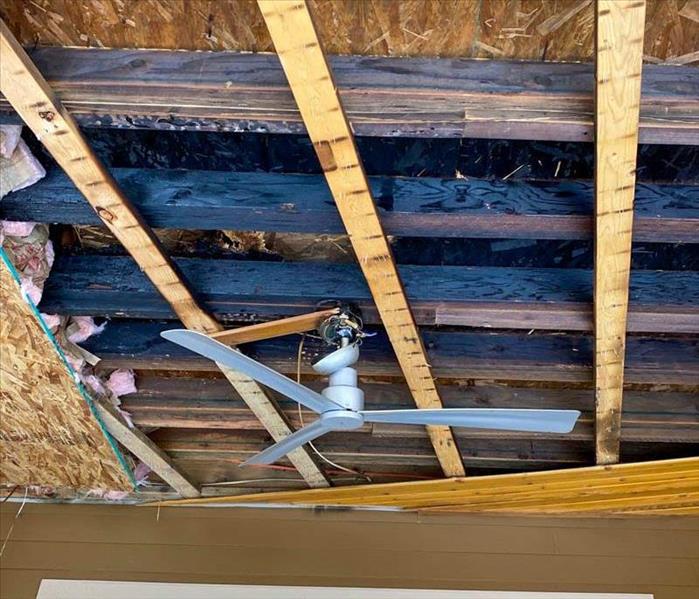 Fire and smoke damage can have devastating consequences, and the road to recovery can seem daunting.
Fire and smoke damage can have devastating consequences, and the road to recovery can seem daunting.
When disaster strikes, such as a fire in your Colorado home or business, the aftermath can be overwhelming. Fire and smoke damage can have devastating consequences, and the road to recovery can seem daunting. In this blog, we will discuss the numerous advantages of hiring professionals to handle fire and smoke damage cleanup in your home. We'll also cover the key reasons why professional restoration services like SERVPRO® should be your top choice for a speedy and effective recovery.
Immediate Response
When dealing with fire and smoke damage, time is of the essence. Hiring professionals means you get an immediate response. SERVPRO® of North Thornton/Brighton has a 24/7 emergency service, ensuring that we can start the restoration process as soon as possible to prevent further damage.
Comprehensive Assessment
Professional restoration companies have the expertise to conduct a thorough assessment of the damage. They identify hidden issues, such as structural damage or compromised air quality, which might not be immediately apparent to the untrained eye. This ensures that all damage is addressed during the cleanup process.
Safety and Health
Safety is paramount when dealing with fire and smoke damage. Professionals like SERVPRO® are trained to handle hazardous materials and know how to use protective gear. They can also address potential risks by ensuring proper disposal of contaminated materials and thorough cleaning.
Specialized Equipment
Effective restoration requires specialized equipment. Professional teams have access to state-of-the-art tools and technology that can clean and deodorize areas affected by smoke and soot. They use industry-specific gear to ensure your property is restored to its pre-damage condition.
Reducing Secondary Damage
One of the key benefits of hiring professionals is their ability to prevent secondary damage. Smoke and soot residues can continue to damage your property even after the fire is out. Professionals use the right techniques to stop this from happening.
Insurance Assistance
Navigating insurance claims can be complex and stressful. Professional restoration companies often have experience working with insurance companies and can help streamline the claims process. This reduces your burden during a challenging time.
Faster Recovery
Fire and smoke damage can disrupt your life or business operations. Hiring professionals can significantly expedite the recovery process, allowing you to get back to normal life sooner.
Expertise in Content Restoration
Fires can damage not only the structure but also your belongings. Professional restoration companies offer content cleaning and restoration services, helping you salvage sentimental or valuable items.
Peace of Mind
Knowing that experts are handling the restoration process provides peace of mind. You can focus on other aspects of recovery while they handle the cleanup.
When it comes to fire and smoke damage cleanup in Colorado, hiring professionals like SERVPRO® of North Thornton/Brighton is the smart choice. Their expertise, immediate response, specialized equipment, and commitment to your safety make them the preferred option for restoring your property. Don't face the challenges of fire and smoke damage alone; let the professionals help you recover and rebuild.
If you're dealing with the aftermath of a fire in the greater Brighton, CO, area, contact our SERVPRO® team for immediate assistance and reliable restoration services. We're here to help you through every step of the recovery process!
Attic Mold: Causes, Prevention, and Solutions
11/13/2023 (Permalink)
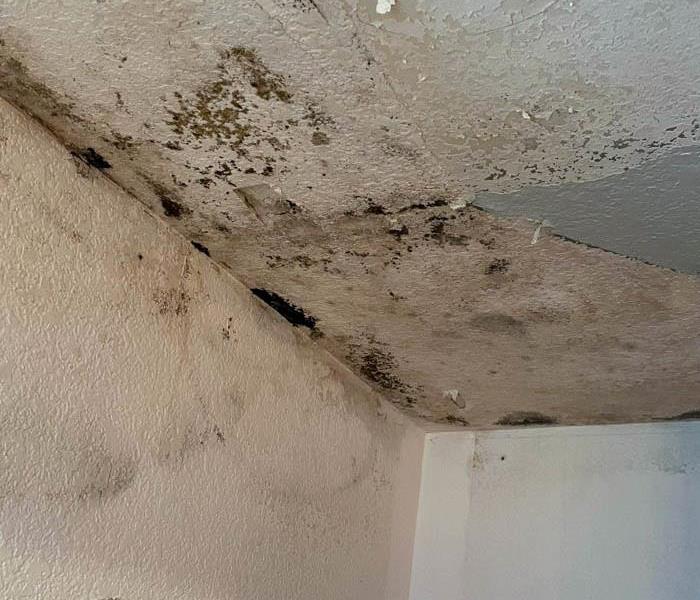 Mold growth in your attic can be a significant concern for homeowners in Thornton, CO.
Mold growth in your attic can be a significant concern for homeowners in Thornton, CO.
Mold can pose a significant challenge for homeowners, impacting the overall condition of your home and its environment. In this blog, we will delve into the causes of mold growth in your attic and offer practical solutions to effectively tackle this issue.
Causes of Mold in Your Attic
- Poor Ventilation: In Thornton, CO, where temperatures can vary greatly, poor attic ventilation is a common culprit for mold growth. When warm, moist air from your home rises into the attic and meets cooler surfaces, condensation can occur, creating an ideal environment for mold.
- Roof Leaks: The occasional heavy rains and snowfall in Thornton can lead to roof leaks. If water finds its way into your attic, it can create damp conditions in which mold thrives.
- Inadequate Insulation: Insufficient attic insulation can cause temperature imbalances, making it easier for moisture to accumulate and mold to grow.
- High Humidity: Thornton's climate can be humid, especially in the summer. If your attic isn't properly sealed or insulated, it can become a breeding ground for mold.
- Improper Exhaust Systems: Appliances like bathroom fans or kitchen vents that exhaust air into the attic rather than outside can contribute to elevated humidity levels.
Solutions for Mold Prevention and Remediation
- Improve Attic Ventilation: Ensure your attic is adequately ventilated. Proper ventilation helps regulate temperature and humidity, reducing the risk of mold growth. Consider installing roof vents or soffit vents if needed.
- Regular Roof Inspections: Have your roof inspected regularly to identify and repair any leaks promptly. Addressing leaks can prevent water from entering your attic and causing mold problems.
- Attic Insulation: Invest in proper attic insulation to maintain a consistent temperature and reduce moisture buildup. Quality insulation can also help lower your energy bills.
- Humidity Control: Use a dehumidifier in your attic to control humidity levels, especially during humid months. Ensure that exhaust fans from bathrooms and kitchens vent outside, not into the attic.
- Mold Remediation: If you already have a mold problem, it's essential to address it promptly. Mold remediation professionals, like SERVPRO® of North Thornton/Brighton, can safely and effectively remove mold from your attic, ensuring it doesn't return.
- Regular Maintenance: Make it a habit to inspect your attic for signs of water damage or mold growth at least once a year. Catching issues early can save you from costly repairs later.
Mold growth in your attic can be a significant concern for homeowners in Thornton, CO. By understanding the causes and implementing the solutions mentioned above, you can protect your home and family from the harmful effects of mold. If you're dealing with a severe mold problem or need professional assistance, SERVPRO® of North Thornton/Brighton is here to help. Contact us today for expert mold remediation and restoration services. Your safety and peace of mind are our top priorities.
How to Prevent Bacterial Growth After Water Leaks in Colorado
10/8/2023 (Permalink)
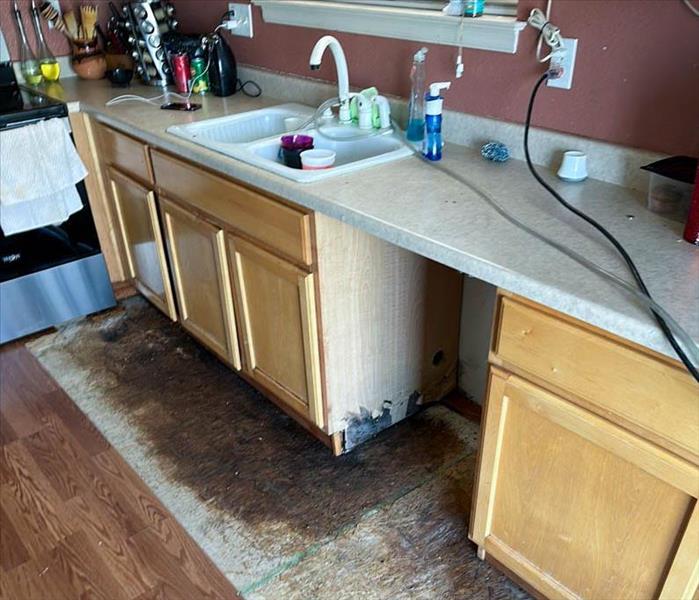 When water invades your home or business, it's essential to act quickly to prevent the growth of harmful bacteria.
When water invades your home or business, it's essential to act quickly to prevent the growth of harmful bacteria.
Living in the Centennial State, we know that water damage is a common issue, often due to heavy snowfall, rain, or flooding. When water invades your home or business, it's essential to act quickly to prevent the growth of harmful bacteria. In this blog, we'll guide you through the steps to ensure a safe and bacteria-free environment in your property.
Understanding the Threat
Water intrusion, whether from a burst pipe, roof leak, or natural disaster, creates a perfect breeding ground for bacteria and other pathogens. Colorado's climate, with its varying temperatures and humidity levels, can exacerbate the problem. Bacteria thrive in moist and warm environments, making it crucial to address water damage promptly and effectively.
Start with a Thorough Cleanup
After a water intrusion event, the first step is to remove all standing water and moisture from your property. Use pumps, vacuums, and dehumidifiers to ensure every nook and cranny is dry. Be diligent, as even small pockets of moisture can lead to bacterial growth.
Inspect for Hidden Moisture
Colorado's unique geography can make water intrusion tricky to detect, as water can seep into walls, floors, and ceilings. Utilize moisture detection equipment to identify hidden moisture pockets. Pay special attention to areas prone to water damage, like basements and attics.
Remove Damaged Materials
Any materials that cannot be adequately dried or cleaned should be removed and replaced. This includes drywall, insulation, and flooring. This not only prevents bacterial growth but also reduces the risk of mold development.
Thorough Cleaning and Disinfection
Once your property is dry and damaged materials are removed, it's essential to clean and disinfect all affected areas. Use EPA-approved disinfectants to eliminate bacteria and viruses. This step is crucial for ensuring a safe and healthy environment for you and your family.
Proper Ventilation
Colorado's dry climate can be an advantage when dealing with water intrusion. Use natural ventilation, like opening windows and doors, to help speed up the drying process. Additionally, consider using fans and air purifiers to circulate air and remove airborne contaminants.
Regular Monitoring
Even after the initial cleanup, it's essential to continue monitoring the moisture levels in your property. Regularly check for signs of new leaks or moisture buildup to prevent future bacterial growth.
Preventing bacterial growth after water intrusion in Colorado is essential for the safety of your loved ones and the longevity of your property. By following these steps and acting swiftly, you can minimize the risks associated with water damage and ensure a clean and safe environment. However, if you ever find yourself facing a significant water intrusion event, don't hesitate to reach out to SERVPRO of North Thornton/Brighton for professional assistance. Our experienced team is here to help you restore your property to its pre-damage condition and keep Colorado homes and businesses safe.
Staying Safe During Thunderstorms: Dos and Don'ts
9/13/2023 (Permalink)
Thunderstorms are a common occurrence in the Northwest, especially during the spring and summer months. These storms can bring heavy rain, strong winds, lightning, and even hail. It is important to take precautions and know what to do to stay safe during thunderstorms. In this blog post, we will discuss the dos and don'ts of staying safe during Northwest thunderstorms.
Dos:
Find shelter in a sturdy building or a hardtop vehicle during a thunderstorm. Avoid open areas, tall objects, and bodies of water. Stay tuned to local news, weather forecasts, or use reliable weather apps to stay informed about the thunderstorm's progress and potential hazards.
Unplug sensitive electronic equipment to protect them from power surges caused by lightning strikes. Bring in or secure outdoor furniture, equipment, and other objects that could be blown away or damaged by strong winds. Close windows and doors to prevent rain, wind gusts, and debris from entering your home or building.
Stay away from swimming pools, lakes, rivers, and other bodies of water during thunderstorms, as lightning can strike these areas. Install surge protectors to protect your electrical devices from power surges caused by lightning strikes. Avoid using corded phones and avoid touching or being in contact with metal objects such as pipes, fences, and electrical equipment, as they can conduct electricity.
Don'ts:
Avoid seeking shelter under trees during a thunderstorm, as they can attract lightning strikes and pose a significant risk of injury. Using corded phones during a thunderstorm can expose you to the risk of a lightning strike. It is best to use mobile phones or cordless phones instead. Stay away from windows and doors during a thunderstorm, as strong winds or flying debris could cause glass breakage or injury.
Pay attention to flood warnings and avoid driving or walking through flooded areas. It is challenging to determine the depth and strength of floodwaters, which can be dangerous. Avoid open fields, hilltops, or other exposed areas during a thunderstorm. Seek shelter in a building or a hardtop vehicle to minimize the risk of lightning strikes. Do not wait outside during a thunderstorm in the hope that it will pass quickly. Take shelter indoors until the storm has completely passed.
Thunderstorms can be dangerous, and it is important not to downplay the risks associated with lightning, strong winds, and heavy rain. Take the necessary precautions to stay safe.
Being aware of the dos and don'ts during Northwest thunderstorms is crucial for staying safe. By following these guidelines, such as staying indoors, monitoring weather updates, securing outdoor items, and avoiding contact with metal objects or open water, you can reduce the risks associated with thunderstorms. Remember to prioritize your safety and take precautionary measures whenever thunderstorms are forecasted.
9 Tips for Eliminating Cigarette Odor
8/14/2023 (Permalink)
For homeowners and property owners, maintaining a clean and fresh living space is essential for a healthy and inviting environment. However, eliminating cigarette odor can be a challenging task. Whether you've recently quit smoking or moved into a new property with lingering smoke smells, it's crucial to create a smoke-free home for the well-being of your family and guests. Here are some effective tips and techniques to eliminate cigarette odor and breathe new life into your living space.
1. Deep Cleaning is Key
The first step in banishing cigarette odor from your home is a thorough deep cleaning. Wash all surfaces, including walls, ceilings, floors, and windows, using a mixture of warm water and vinegar or an odor-neutralizing cleaner. Don't forget to clean curtains, blinds, and any fabric materials that may have absorbed the smoke smell.
2. Air Out Your Home
Open all windows and doors to let fresh air circulate through your home. Proper ventilation is essential in removing stale cigarette smoke. Consider using fans or air purifiers to help expedite the process and improve indoor air quality.
3. Use Activated Charcoal
Activated charcoal is known for its excellent odor-absorbing properties. Place bowls of activated charcoal in different rooms, and it will naturally absorb and neutralize the cigarette smell over time.
4. Baking Soda - The Odor Buster
Baking soda is a fantastic natural deodorizer. Sprinkle it on carpets, upholstery, and other fabric surfaces. Let it sit for a few hours before vacuuming it up. Baking soda can help neutralize and absorb the lingering smoke odors effectively.
5. The Power of Vinegar
Vinegar is a versatile and inexpensive solution for combating cigarette odor. Place small bowls of white vinegar around your home to absorb odors. You can also use a mixture of vinegar and water to wipe down surfaces and remove the smoky film.
6. Opt for Air Purifiers
Investing in high-quality air purifiers with activated carbon filters can significantly improve indoor air quality by capturing and neutralizing cigarette odors. Look for purifiers designed specifically for smoke removal.
7. Don't Forget the Carpets
Carpets are notorious for holding onto odors. Consider steam cleaning your carpets or hiring professional carpet cleaners who specialize in odor removal to tackle the smoky residue effectively.
8. Avoid Smoking Indoors
If you're a smoker, make a conscious effort to smoke outdoors to prevent the smell from permeating your home. Designate a smoking area away from entry points to reduce the likelihood of smoke seeping indoors.
9. Regular Cleaning and Maintenance
Maintain a smoke-free home by adopting a regular cleaning routine. Vacuum carpets, dust surfaces, and clean upholstery on a consistent basis to prevent smoke buildup.
Creating a smoke-free home is an achievable goal with the right techniques and dedication. By deep cleaning, using natural deodorizers like baking soda and vinegar, and investing in air purifiers, you can successfully eliminate cigarette odor from your living space. Regular maintenance and adopting smoke-free habits will help ensure your home remains fresh and inviting for your family and guests. Say goodbye to smoke odors and embrace a healthier and more pleasant living environment.
 In this blog, we will explore the role of insurance in fire damage restoration, how it is involved, and how coverage affects your remediation process.
In this blog, we will explore the role of insurance in fire damage restoration, how it is involved, and how coverage affects your remediation process.






 24/7 Emergency Service
24/7 Emergency Service





